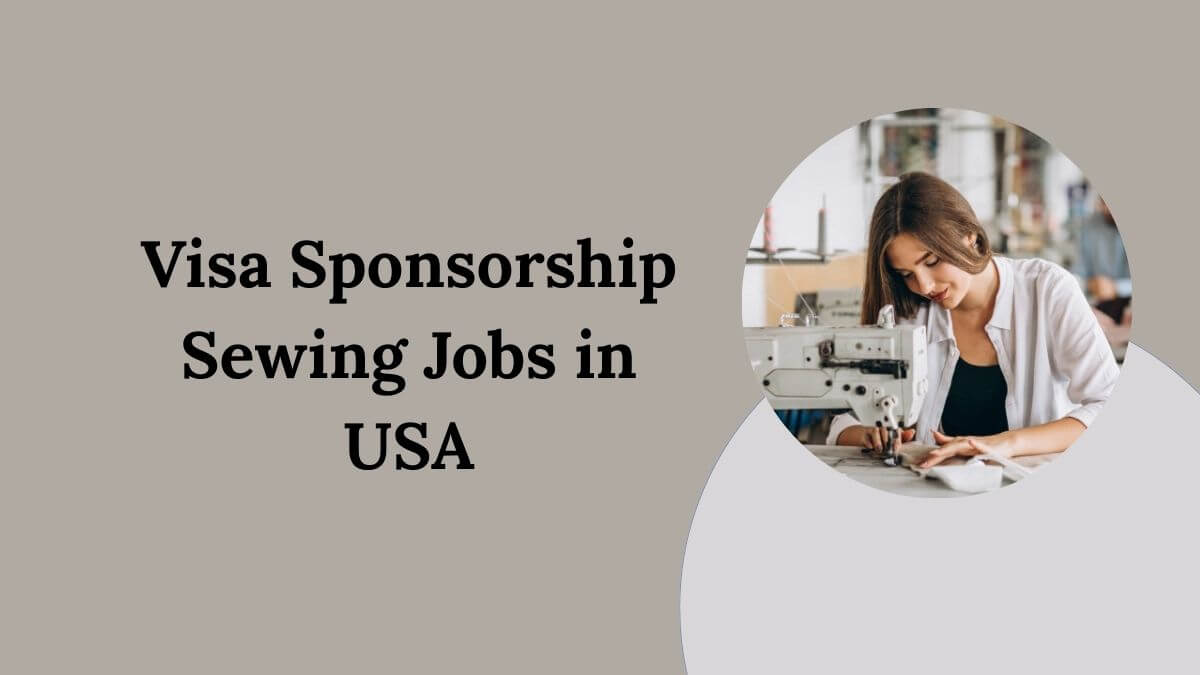
Visa Sponsorship Sewing Jobs in USA 2025 – Apply Now
Along with the growth of the U.S. clothing and manufacturing industries, there will be a bigger need for qualified Sewing Machine Operators and Tailors in 2025. People who work with specific clothing, upholstery, textiles, and uniforms should really think about this. There aren’t enough workers in the US, so many clothing and textile companies are now paying for skilled foreign workers to get visas. In the U.S., sewing machine workers and tailors usually make between $28,000 and $45,000 a year. Experienced professionals and those who work in specialized fields make more.
Key Points:
- Job Title: Sewing Professional (Various Roles)
- Location: United States (Multiple locations depending on employer)
- Visa Sponsorship: Available (H-2B, EB-3, or other relevant work visas)
Requirements for Visa Sponsorship Sewing Jobs in USA:
- Educational Background: Sometimes, you need a high school diploma or a general education diploma (GED) to work as a SOC 261 employee.
- Work Experience: It might be helpful to have work experience in the fashion design, cloth, or stitching industries.
- Technical Proficiency: The candidate must know how to use sewing tools, cut materials, and work with different kinds of fabrics. It is also very important to know about measurements, trends, and changes.
- Attention to Detail: The level of delicacy and tightness of work are very important in sewing jobs, especially those that involve fashion designer clothes or clothes that are made to order.
Duties of Sewing Jobs in USA:
- Fabric Cutting and Measuring: It is very important to follow the right steps for cutting and measuring during the production process to make sure the finished product meets all the requirements.
- Reading and Following Patterns: Tailors and seamstresses need to be able to fully understand pattern directions, layouts, and any other technical drawings in order to make certain textiles or clothes.
- Making Changes to Clothes: Many sewing jobs require making changes to clothes, like hemming, trimming, or fixing clothes that are broken in some way.
- Quality Control: Part of the job is to make sure that the products are defect-free and that the seams have the right number of stitches and that there are no obvious loose threads.
Check Also: Tailor Jobs in New Zealand with Visa Sponsorship
Tailoring and Garment Industry Jobs in USA:
The US clothing and tailoring business is growing quickly, which is good news for skilled workers all over the world. Foreign workers with skills in textiles and clothing can now look for steady job opportunities, often with visa sponsorship. These include jobs as a sewing machine operator in the USA and specialized roles in embroidery and stitching jobs USA.
Why the Tailoring and Garment Industry in USA is Growing:
The U.S. clothing and textile market is still doing very well thanks to growing consumer demand, the growth of e-commerce, and the need for customized clothing. Because of this rise, there is more demand for:
- Professional tailors
- Sewing machine operators
- Embroidery specialists
- Upholstery and fabric workers
For foreigners looking for work, this industry not only offers good pay, but also long-term stability and the chance to be sponsored.
Sewing Machine Operator Careers USA:
The job of sewing machine operator is one of the most sought-after in the clothing industry. These people are in charge of operating industrial sewing machines that are used to make clothes, uniforms, and other items.
Key Highlights:
- Salary Range: $28,000 – $45,000 annually
- Job Outlook: A lot of people want to buy textiles in places like California, New York, Texas, and North Carolina.
- Visa Sponsorship: Due to a lack of local workers, many firms and textile companies hire people from other countries.
So, sewing machine operator jobs in the USA are a good place for people from other countries to start their careers.
Embroidery and Stitching Jobs USA:
Embroidery and stitching jobs USA are another growing area of the U.S. clothing business. The main duties of these jobs are to do creative sewing, brand-building, and customizing uniforms for business and retail customers.
In this field, some roles are:
- Embroidery Machine Operators
- Hand Stitching Specialists
- Custom Apparel Finishers
More people want personalized and branded clothing, which means that embroidery workers can find steady work all over the U.S.
Benefits of Sewing Jobs:
- Stable Demand: People will always need clothes, uniforms, furniture, and textiles, so sewing jobs are still a good way to make a living.
- Creative Work: Custom designs, alterations, and the building of clothes made by sewing allow people to show off their creativity.
- Chances to Get a Visa: Many textile and clothes companies in the U.S. hire foreign workers when they need more workers.
- Competitive Pay: People who work as seamstresses can make steady incomes, and those who specialize in high-end, custom, or industrial clothes can make even more.
- Skill Development: Employees learn how to make patterns, handle fabric, and use advanced stitching methods.
- Career Flexibility: If you know how to sew, you can work for yourself, own a small business, or work for big fashion and textile companies.
- Contribution to Industry Growth: Sewing professionals are very important to the fashion, manufacturing, and upholstery businesses around the world.
Salary Expectations:
In the United States, sewing job pay depends on where the job is located, how much experience the person has, and the job description that is in place. People who work as seamstresses can expect to make:
- Entry-Level Positions: Entry-level jobs pay between $25,000 and $35,000 a year.
- Expert Sewers: This amount is usually between $28,000 and $45,000 per year.
- Specialized Positions: For specialized jobs like pattern makers and tailors, the yearly pay is between $40,000 and $60,000.
- Supervisory Positions: For supervisory jobs, the pay range is $50,000 to $75,000 per year.
Types of Jobs:
- Tailor: A tailor is a trained professional who makes clothes for specific customers, changes them by adding or taking away sizes, and fixes them.
- Seamstress/Seamster: Sewers, tailors, or stitchers who make and join clothes, accessories, or home textiles are called seamstresses or seamsters.
- Pattern Maker: It is the job of pattern makers to make clothing patterns that match what the artist wants. They are also involved in making and preparing clothes.
- Specialist Costume Designer: Specialty costume designers, like theatrical costume makers and tailors, plan and sew outfits for burlesque shows, movies, and other events.
- Upholsterer: Sewers make furniture, seats for transportation vehicles, and other similar things of a similar nature.
- Embroidery Machine Operator: As an embroidery machine operator, you will use an embroidery machine to add small details, emblems, or brand logos to clothes and fashion fabrics.
- Assembler of Garments: Assemblers of garments are factory workers who put together and sew together parts of clothes and other items that go with them.
- Worker in the textile Industry: This includes people who weave, knit, and spin fabrics, as well as people who make clothes out of fabrics and people who check the quality of the clothes.
- Sewing Supervisor: It is the job of sewing supervisors to make sure that the production and quality goals are met by managing the sewing sub-groups.
- Industrial Sewing Machine Operator: This job involves using industrial sewing machines in a factory to sew through thick materials like leather and cloth.
Application Process:
- Job search platforms: These include social networks, websites that help you find jobs, forums, job-related message boards, company websites, and traditional career sites.
- Make a Resume and a Portfolio: Write a resume that lists your sewing experience, skills, achievements, and qualifications. If it is possible, include a collection of the best work you have done so far.
- Apply for Jobs Online: You can send your resume and cover letter directly to the company’s website, to online job search sites that are currently open, or to employment companies that focus on textile and sewing jobs.
Frequently Asked Questions:
Can I make a career out of sewing?
Sewing is a skill, and if you sew clothes, you can make enough money by making custom dresses, doing job work or contract sewing, and teaching people how to sew. You could also use a store, fashion house, shop, or something else.
What is professional sewing called?
A seamstress or seamster does a lot of the same things as a tailor, but they may also have special skills, like being able to measure and fit customers. Hemming and making other changes. Sewing by hand and with a sewing machine. Labeling clothes and other things that need to be changed.
Is sewing a good business?
Starting a sewing business can be very profitable, especially since you may already have a lot of the tools you need and don’t have to spend a lot of money on them. Once you know what kind of sewing business you want to start, you need to figure out how to sell your goods.



